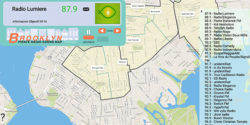Last week The Verge wrapped up a three-part series on pirate radio, examining a US-government-sanctioned form in Afghanistan, radio-like conference call services used by the Hmong diaspora and unlicensed Haitian stations in Brooklyn, NY. Recovering from the holiday weekend I finally had a chance to catch up, read the three articles and listen to their accompanying podcasts. They’re well-researched pieces that put the production and use of radio in social and political economic context, rather than relying on well-worn tropes of over-romanticized rebellion (not a single skull-and-crossbones image to be found!).
The value of radio communication to communities that are not well served by mainstream broadcasters is something we’ve emphasized here at Radio Survivor when discussing unlicensed or pirate radio. For the article on Brooklyn stations, reporters Bijan Stephen and Andrew Marino use the looming specter of the PIRATE Act as a frame for understanding why government prohibition, even escalated by the threat of multiplied fines, poses little disincentive for the unlicensed broadcaster serving their friends, families and neighbors.
Stephen and Marino profile a former news program host on an unlicensed station, Joan Martinez, who studied broadcasting in college. Now in graduate school, Martinez reflects a first-person insider’s view that is informed by her broader understanding of the tightly controlled radio industry, especially in New York City, where opportunities for new stations are few and far between.
In fact, only three low-power FM stations are licensed in the entire city: one in Brooklyn, one in Queens and one in Flushing. All were approved only in the last LPFM licensing window, and have been on the air only a few years. Just one LPFM seems hardly enough to serve the diverse needs of Brooklyn alone, home to 2.5 million people.
For the podcast the hosts talk with scholar John Anderson, who has been studying pirate radio for some two decades, and journalist David Goren, who created the Brooklyn Pirate Radio Sound Map. Both John and David discussed the Brooklyn scene on our podcast last year.
David’s comments on why he thinks the PIRATE Act will not do much to stem the tide of pirate radio were particularly incisive. He predicted, “it will be gentrification that takes the pirate stations off the air,” as new, high-rent residential high-rise buildings go up in the Flatbush neighborhood that is home to countless broadcasters.
That’s probably true, and it’s also likely that stations will spread out to new areas as people are pushed out or Brooklyn by a skyrocketing cost of living. At the same time, pirate radio is a pervasive phenomenon throughout the New York City area. I’m not sure other hotbeds, like Paterson, NJ, will gentrify at the same rate. Nevertheless, the point is well taken. Go to other cities with prominent ethnic and immigrant communities, but where they’re not so densely clustered as around NYC, and you’ll encounter far less pirate radio, too.
Calling the Radio
While comparisons of other media to pirate radio – like internet radio, in particular – often grates on me, I’m fine with reporter Mia Sato’s likening Hmong conference call services to it. These conferences are as similar to terrestrial radio as podcasts and internet radio. While not legally prohibited, like pirate radio, they serve a very similar communitarian function as the Haitian stations in Brooklyn, though obviously with the opportunity for more immediate dialog.
Moreover, telephone and radio have been intricately tied pretty much since the beginning, noting that radio was a two-way medium before one-to-many broadcasting came to predominate. And, of course, listener calls have long been a feature, making the one-way medium more two-way.
Outside of broadcast, amateur radio and citizens’ band radio are also two-way, where monopolizing a frequency to broadcast is actually prohibited. So I see these conference call “stations” as a sort of hybrid.
Back to the radio-telephone connection. There have long been stations that also simulcast on the telephone to reach listeners without access to their air signals. In the days before cell phone and unlimited minutes, this could be an expensive service for listeners outside of a station’s immediate area. But today that’s much less of a concern.
In fact, a couple of dozen stations around the world currently simulcast over the phone using a service called Audio Now, including BBC World Service and Voice of America service programs in Somali, as well as news radio WTOP in Washington, DC. If you’re low on smartphone data and don’t have access to a radio, then it’s not a bad alternative.
The Irony of the Radio in a Box in Afghanistan
The first article in the series tells the story of Afghan broadcasters who were given a “radio in the box” to broadcast on behalf of U.S. military PsyOps during the heat of the American invasion. These broadcasters created programming in opposition to the Taliban, including popular music, alongside news and propaganda. Unfortunately, they were also left high-and-dry when the U.S. military pulled out.
Radio has long been a tool of war, and of those opposing totalitarian rule, both from within and outside the borders of conflict zones. Of course, it’s hard to escape the irony that the American government is happy to promote pirate radio elsewhere, while simultaneously working to stamp it out at home. But any student of history should know such ironies are not that rare.



